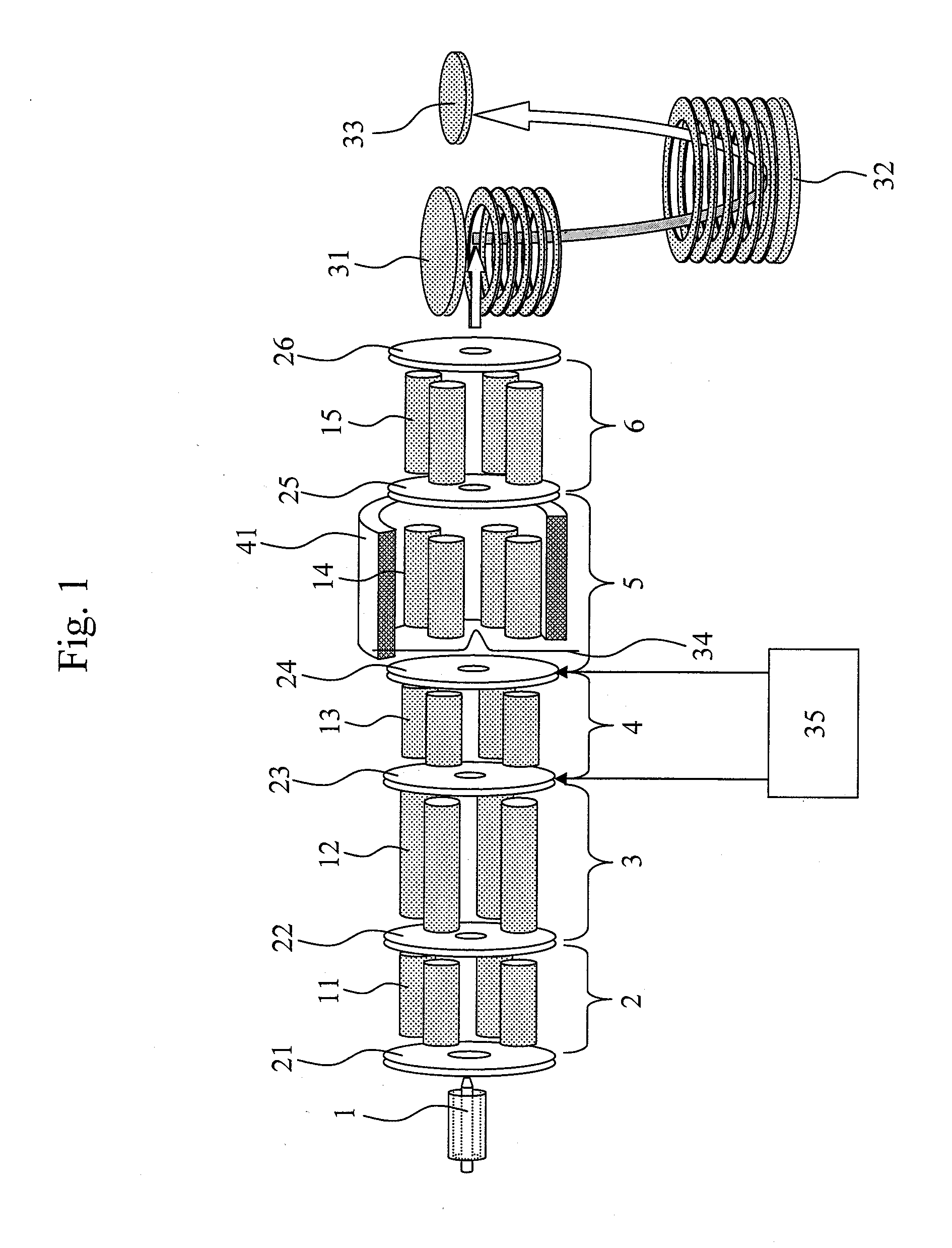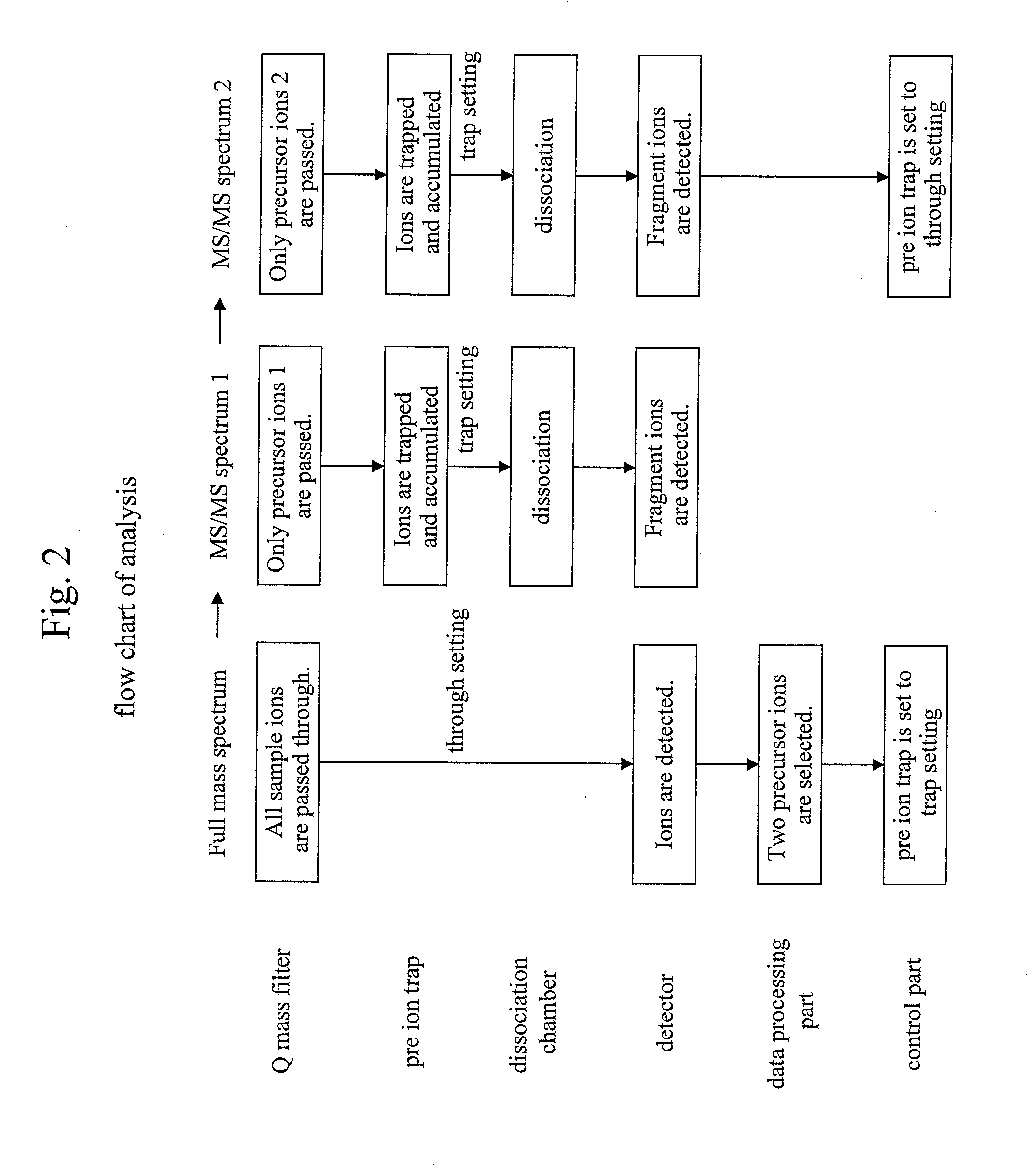Mass spectrometer and method of mass spectrometry
a mass spectrometer and mass spectrometer technology, applied in mass spectrometers, separation processes, dispersed particle separation, etc., can solve the problems of inability to perform tandem mass spectrometry (ms/ms), travel-wave type dissociation chambers are not capable of tandem mass spectrometry, etc., to prevent an ion loss, the effect of increasing the reaction time and closer to 100%
- Summary
- Abstract
- Description
- Claims
- Application Information
AI Technical Summary
Benefits of technology
Problems solved by technology
Method used
Image
Examples
embodiment 1
[0038]FIG. 1 is a diagram for describing an embodiment of a mass spectrometer including a quadrupole mass filter, a pre ion trap, an ion dissociation chamber, and TOF mass spectrometers. The flow in the mass spectrometer is as follows. An analysis target sample separated by a liquid chromatograph or the like is ionized in an ion source 1. The sample ions obtained by the ionization pass a linear quadrupole ion guide unit 2, a quadrupole filter 3 and a pre ion trap 4 inside a vacuum device. Thereafter, the sample ions enter an ion dissociation chamber 5, and are dissociated there. The fragment ions obtained by the dissociation are measured by TOF mass spectrometers 31 to 33, whereby a mass spectrum is obtained.
[0039]FIG. 2 describes a flow chart of an analysis. In this embodiment, a full mass spectrum is acquired, from which two kinds of precursor ions are determined as structural analysis targets. Thereafter, two MS / MS spectra are acquired by dissociating the precursor ions. After th...
embodiment 2
[0049]FIG. 5 is a diagram for describing another embodiment of the mass spectrometer including a quadrupole mass filter 3, a pre ion trap 4, and an ion dissociation chamber 51. This embodiment is a case where CID or ETD is carried out in the ion dissociation chamber 51. In the case of performing ETD, negative ions are generated in a negative ion source 42; the negative ions are subjected to isolation in a quadrupole filter 57; and the resultant ions are deflected by 90 degrees in a quadrupole deflector 52, and are introduced into the ion dissociation chamber 51. The quadrupole deflector 52, the quadrupole filter 57, and the negative ion source 42 may be inserted between the pre ion trap 4 and the ion dissociation chamber 51. The quadrupole filter 57 may be replaced with some other device as long as, like an ion trap, the device is capable of isolation. Furthermore, ECD can be carried out by: replacing the negative ion source 42 with an electron source; providing the ion dissociation...
embodiment 3
[0051]FIG. 6 is a diagram for describing yet another embodiment of the mass spectrometer including a quadrupole mass filter 3, a pre ion trap 4, and ion dissociation chambers 51, 54. This embodiment is a case where: CID is carried out in the ion dissociation chamber 51; and ECD is carried out in the ion dissociation chamber 54. This embodiment includes the two ion dissociation chambers, and the ion dissociation chamber 54 exists on a line that is located on a different line away from a straight line joining the ion source and the detection system. The introduction of ions into the ion dissociation chamber 54 from the ion source is achieved by deflecting the ions by 90 degrees by use of the quadrupole deflector 52. Thereafter, electrons are introduced into the ion dissociation chamber 54 from an electron source 42. The ECD is performed in the ion dissociation chamber 54. An operation method of accumulating ions in the pre ion trap 4 while either of the two ion dissociation chambers i...
PUM
 Login to View More
Login to View More Abstract
Description
Claims
Application Information
 Login to View More
Login to View More - R&D
- Intellectual Property
- Life Sciences
- Materials
- Tech Scout
- Unparalleled Data Quality
- Higher Quality Content
- 60% Fewer Hallucinations
Browse by: Latest US Patents, China's latest patents, Technical Efficacy Thesaurus, Application Domain, Technology Topic, Popular Technical Reports.
© 2025 PatSnap. All rights reserved.Legal|Privacy policy|Modern Slavery Act Transparency Statement|Sitemap|About US| Contact US: help@patsnap.com



